Beaufort Mk.VII/VIII
Conversion Set
to suit Airfix 1/72 kit
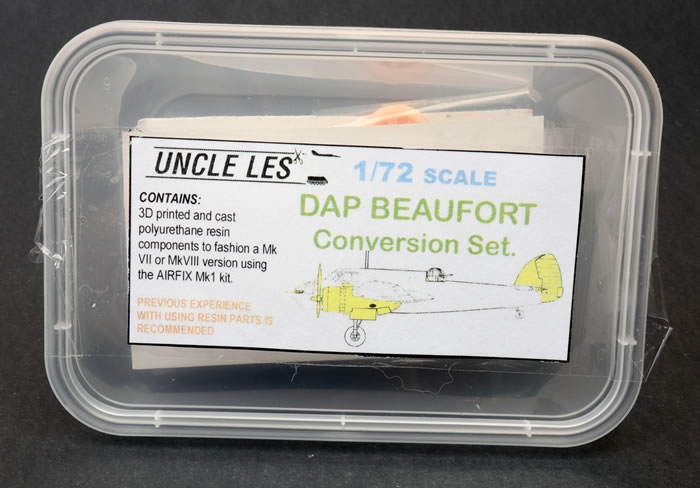
Uncle Les, 1/72 scale
S u m m a r y : |
Catalogue Number: |
Uncle Les 1/72 scale Beaufort Mk.VII/VIII Conversion Set |
Scale: |
1/72 |
Contents & Media |
14 parts 3D printed in salmon colour; three parts in grey coloured resin; five page A4 page instruction booklet. |
Price: |
AUD$30.00 including postage to Australia available from Uncle Les' Facebook page
Note that this conversion will be manufactured in very small quantities and will only appear on the Uncle Les Facebook page when the conversion is actually in stock. |
Review Type: |
First Look. |
Advantages: |
Well-researched; everything you need for an Australian manufactured Beaufort Mk.VII or VIII; detailed instructions for every step along the way. |
Disadvantages: |
Extra care required for parts removal and preparation; engine push rods and wiring harness need repair / replacement; some rough spots and striations will need cleaning up. |
Conclusions: |
This is a comprehensive conversion for the Australian produced Beaufort Mk.VII and VIII.
If you demand flawless resin castings with minimal preparation, you might want to move along. However, if you are willing to put in a bit of effort in order to deliver a unique or long hoped for subject, and you don't mind exercising your actual modelling skills, this could be for you..
Modellers with some experience using resin parts should have no trouble, although I do recommend taking extra time and care with parts removal and clean-up. Uncle Les' 1/72 scale Beaufort Mk.VII / VIII conversion will be warmly welcomed by RAAF fans everywhere. |
Reviewed by
Brett Green

As the design for the Beaufort began to mature, the Australian Government invited a British Air Mission to discuss the defence needs of Australia and Singapore. It was also a step towards expanding the Australian aircraft industry. The Beaufort was chosen as the best General Reconnaissance (G.R.) aircraft available and on 1 July 1939, orders were placed for 180 airframes and spares, with the specially formed Beaufort Division of the Commonwealth Department of Aircraft Production (DAP).
The Australian Beauforts were to be built at the established DAP plant in Fisherman's Bend, Melbourne, Victoria and a new factory at Mascot, New South Wales; to speed up the process drawings, jigs and tools and complete parts for six airframes were supplied by Bristol. The bulk of Australian-built Beauforts used locally available materials.
One of the decisive factors in choosing the Beaufort was the ability to produce it in sections. Because of this, railway workshops were key subcontractors:
Taurus engines, aircraft components and the associated equipment were shipped out to be joined in October 1939, by the eighth production Beaufort L4448. With the outbreak of war, the possibility that supplies of the Taurus engines could be disrupted or halted was considered, even before the British government placed an embargo on exporting war materials with the Blitzkrieg on France, the Netherlands and Belgium in May 1940. It was proposed that a change of powerplant could be made to the Pratt & Whitney Twin Wasp, which was already in use on RAAF Lockheed Hudsons. Orders for the engine were placed and a factory was set up at Lidcombe, New South Wales and run by General Motors-Holden Ltd. The locally built engines were coded S3C4-G, while those imported from America were coded S1C3-4. Three-bladed Curtiss-Electric propellers were fitted to Beaufort Mks V, VI, VIII and IX while Beaufort Mks VA and VIII used Hamilton Standard propellers.
In early 1941, L4448 was converted as a trials aircraft and the combination was considered a success. The first Australian-assembled Beaufort A9-1 flew on 5 May 1941 with the first Australian-built aircraft A9-7 coming off the production line in August. In total 700 Australian Beauforts were manufactured in six series.
A distinguishing feature of Australian Beauforts was a larger fin, which was used from the Mk VI on. Armament varied from British aircraft: British or American torpedoes were able to be carried and the final 140 Mk VIII were fitted with a locally manufactured Mk VE turret with .50 cal machine guns. A distinctive diamond-shaped DF aerial was fitted on the cabin roof, replacing the loop antenna.
Other Australian improvements included fully enclosed landing gear and Browning M2 .5 in (13 mm) machine guns in the wings. Some were also fitted with ASV radar aerial arrays on either side of the rear fuselage.
The Mk.XI was a transport conversion, stripped of armament, operational equipment and armour and rebuilt with a redesigned centre fuselage. Maximum speed was 300 mph (480 km/h) and a payload of 4,600 lb (2,100 kg) could be carried.
Production of the Australian Beaufort ended in August 1944 when production switched to the Beaufighter.*
As can be seen above, Australian manufactured Beauforts differed very markedly from their British built counterparts with different engines, nacelles, landing gear doors, enlarged fin, different armament and more.
Uncle Les, a short-run multi-media manufacturer from Australia, has been very quick off the mark to produce a 1/72 scale DAP Beaufighter Mk.VII / VIII conversion.
The parts have been designed in CAD and the salmon coloured parts have been 3D printed, with the nacelles and fin being cast in grey resin.
The resin and 3D printed parts are packed snugly between two pieces of cardboard and sticky tape and inside a clear plastic box.
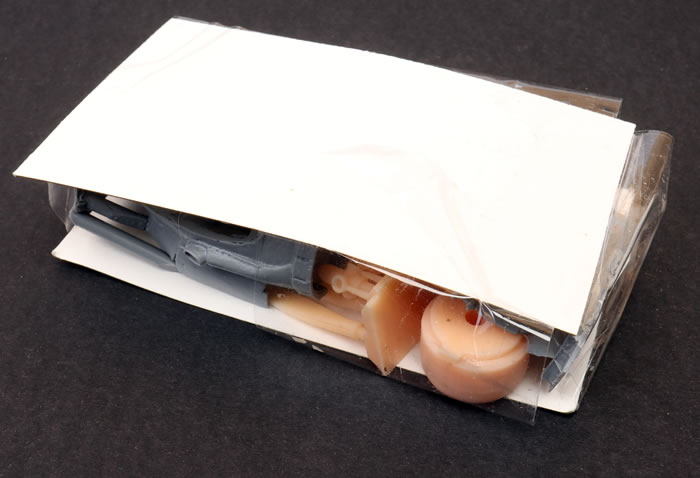
Uncle Les' 1/72 scale Beaufort Mk.VII / VIII comprises 14 3D printed parts in a salmon colour, three parts in grey resin and a five page A4 page instruction booklet.
Contents are:
-
a printed twin front machine gun position for the nose glazing with two guns in place
-
two sets of propeller blades and boss/spinners
-
two 3D printed engine cowls with Twin Wasp engines in place
-
two cast resin engine nacelle replacements with integral undercarriage doors.
-
two printed blanking plates for the upper wing intakes and
-
one cast resin tail replacement
The 3D printed parts are very nicely done.
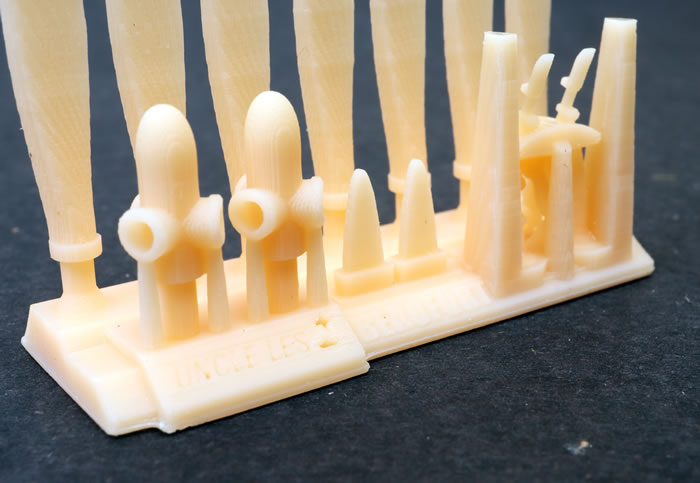
The only issues here are some faint striations on the propeller blades left by the 3D printing process (these will be quicky despatched with a fine sanding stick) and some of the engine pushrods are damaged while the ignition harness is missing. These may be replaced with fine wire or stretched sprue.
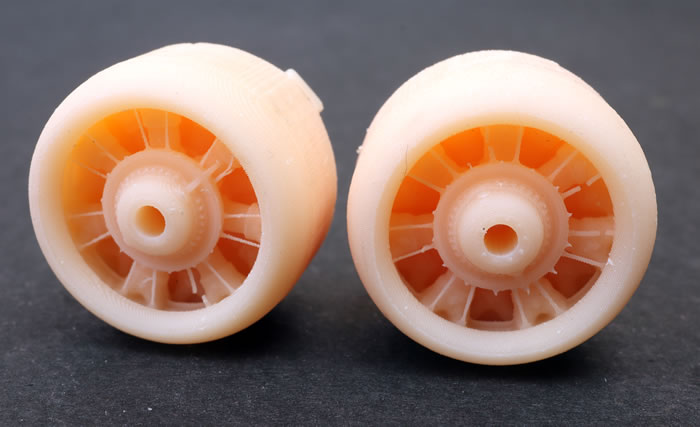
The grey resin nacelles look a little rough on their casting blocks but they'll look fine when they are removed and cleaned up. The nacelles are clevery cast with the new undercarriage doors, intakes and cowl flaps in place.
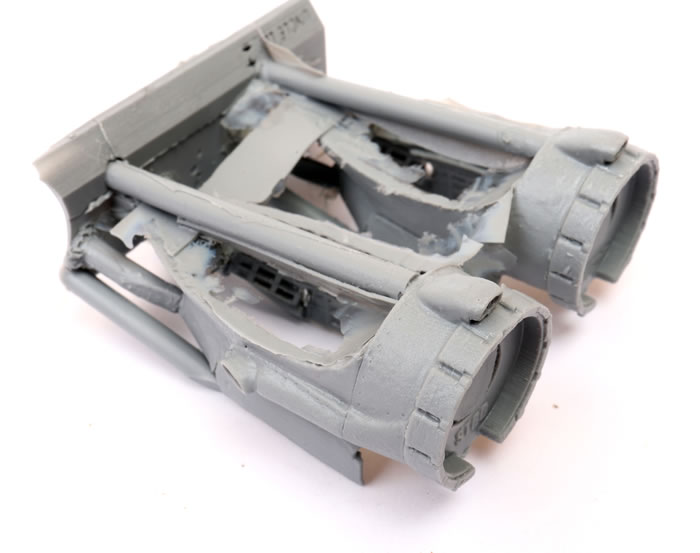
Required surgery to the kit parts is minimal. The engine nacelles will simply slip onto the wing and over the undercarriage legs. The cowlings fit flawlessly into a recess in the front of the nacelles.
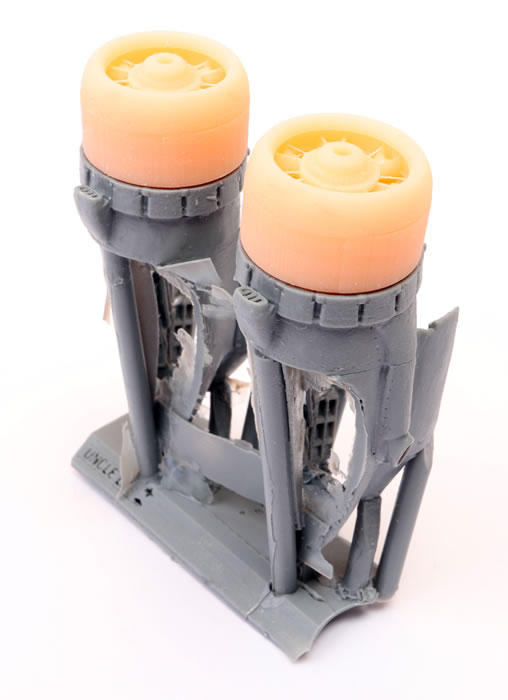
You'll just need to cut the kit fin and rudder off along the panel and hinge lines, then open up a rectangle in the front of the nose glazing for the twin machine guns.
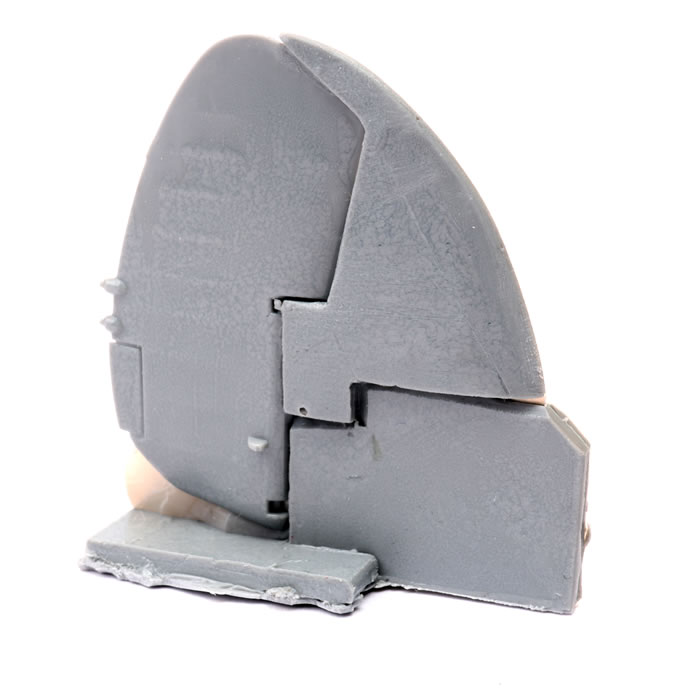
You will need to take extra special care when cutting the clear part though - you'll only have one chance to get it right!
The only other additional task is to check the style of turret fairings. There are three configurations and you should be able to depict any of these with the plastic in the Airfix box.
For the real detail enthusiast, there are also a few modifications that can be made to the kit's turret to improve its accuracy as the Australian version.
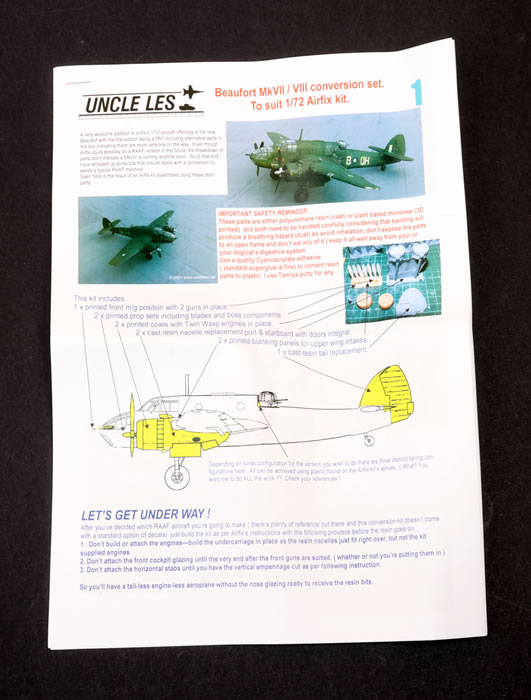
The five-page illustrated kit instructions detail all of this additional work.
This is a comprehensive conversion for the Australian produced Beaufort Mk.VII and VIII.
If you demand flawless resin castings with minimal preparation, you might want to move along. However, if you are willing to put in a bit of effort in order to deliver a unique or long hoped for subject, and you don't mind exercising your actual modelling skills, this could be for you.
Modellers with some experience using resin parts should have no trouble, although I do recommend taking extra time and care with parts removal and clean-up.
Uncle Les' 1/72 scale Beaufort Mk.VII / VIII conversion will be warmly welcomed by RAAF fans everywhere.
* Historical text courtesy of Wikipedia
Thanks to Uncle Lesfor the sample
Review Text & Images Copyright © 2021 by Brett Green
Page Created 14 April, 2021
Last updated
15 April, 2021
Back to HyperScale Main Page

|
